Search results for: 'pillow co'
- Related search terms
- pillow c
- Pillow+r
- pillow+fillin
- pillow p
- Pillow+r.".))(),',
-
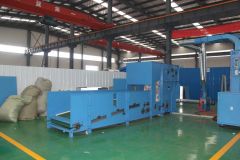 K-5175 AUTOMATIC PILLOW MACHINE WITH HOPPER FEEDREFERENCE NUMBER: K-5175 AUTOMATIC PILLOW MACHINE WITH HOPPER FEED DIMENSIONS: 11700mm X 4000mm X 3000mm POWER: 23.45KW CAPACITY: 8 TO 10 PIECES PER MINUTE LABOR NEED: 1 CONTROL SYSTEM: SIEMENS PLC ELECTRICITY: AS PER CUSTOMER FIBER OPENING RATE: 98%+ WEIGHT: 3650 KG QUANTITY AVAILABLE: 1 Learn More
K-5175 AUTOMATIC PILLOW MACHINE WITH HOPPER FEEDREFERENCE NUMBER: K-5175 AUTOMATIC PILLOW MACHINE WITH HOPPER FEED DIMENSIONS: 11700mm X 4000mm X 3000mm POWER: 23.45KW CAPACITY: 8 TO 10 PIECES PER MINUTE LABOR NEED: 1 CONTROL SYSTEM: SIEMENS PLC ELECTRICITY: AS PER CUSTOMER FIBER OPENING RATE: 98%+ WEIGHT: 3650 KG QUANTITY AVAILABLE: 1 Learn More -
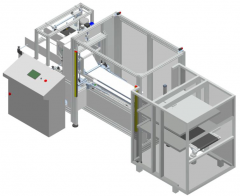 K-1289 AUTOMATIC LINE FOR PACKAGING PILLOWS - BY ROBOT INSERTING ADVERTISING SHEET , AUTOMATIC PLACING INTO PLASTIC BAG, FLATTENING OF PLASTIC BAG AND PUSHING INTO A BOXREFERENCE NUMBER: K-1289 AUTOMATIC LINE FOR PACKAGING PILLOWS - BY ROBOT INSERTING ADVERTISING SHEET , AUTOMATIC PLACING INTO PLASTIC BAG, FLATTENING OF PLASTIC BAG AND PUSHING INTO A BOX FOR THE PACKAGING WITH ROBOTIC MACHINES FOR ALL THE MOVEMENTS: CHECKING, FILLING, PRESSING AND WELDING, SCRAPPING THE MATERIAL IN EXCESS, MOTORIZED OUTPUT INTO CARTON BOXES OF PILLOWS OR CUSHIONS. SPECIFIC FOR AUTOMATIC FILLING OF PILLOWS AND CUSHIONS INTO PLASTIC BAGS WITH PRESSING AND WELDING SYSTEM, SCRAPPING THE MATERIAL IN EXCESS AND THE EJECT OF THE BAGGED PILLOWS INTO BOXES, WITHOUT OPERATORS QUANTITY AVAILABLE: 1 Learn More
K-1289 AUTOMATIC LINE FOR PACKAGING PILLOWS - BY ROBOT INSERTING ADVERTISING SHEET , AUTOMATIC PLACING INTO PLASTIC BAG, FLATTENING OF PLASTIC BAG AND PUSHING INTO A BOXREFERENCE NUMBER: K-1289 AUTOMATIC LINE FOR PACKAGING PILLOWS - BY ROBOT INSERTING ADVERTISING SHEET , AUTOMATIC PLACING INTO PLASTIC BAG, FLATTENING OF PLASTIC BAG AND PUSHING INTO A BOX FOR THE PACKAGING WITH ROBOTIC MACHINES FOR ALL THE MOVEMENTS: CHECKING, FILLING, PRESSING AND WELDING, SCRAPPING THE MATERIAL IN EXCESS, MOTORIZED OUTPUT INTO CARTON BOXES OF PILLOWS OR CUSHIONS. SPECIFIC FOR AUTOMATIC FILLING OF PILLOWS AND CUSHIONS INTO PLASTIC BAGS WITH PRESSING AND WELDING SYSTEM, SCRAPPING THE MATERIAL IN EXCESS AND THE EJECT OF THE BAGGED PILLOWS INTO BOXES, WITHOUT OPERATORS QUANTITY AVAILABLE: 1 Learn More -
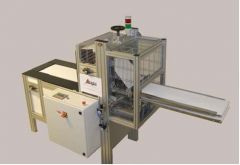 G-6925 ELECTRONIC STUFFING MACHINE FOR PILLOWS AND FURNISHING CUSHIONREFERENCE NUMBER: G-6925 ELECTRONIC STUFFING MACHINE FOR PILLOWS AND FURNISHING CUSHION QUANTITY AVAILABLE: 1 Learn More
G-6925 ELECTRONIC STUFFING MACHINE FOR PILLOWS AND FURNISHING CUSHIONREFERENCE NUMBER: G-6925 ELECTRONIC STUFFING MACHINE FOR PILLOWS AND FURNISHING CUSHION QUANTITY AVAILABLE: 1 Learn More -
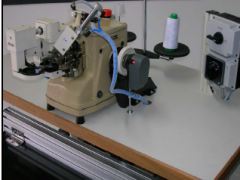 M-1020-F SPECIAL SEWING MACHINE MODEL 164CSPECIAL SEWING MACHINE FOR CLOSING PILLOWS, CUSHIONS FOR FURNISHING AND UPHOLSTERY PRODUCTS THIS MACHINE IS SPECIFIC FOR THE CLOSING OF ROLOFIL CUSHIONS, FEATHER PILLOWS, CARDER CUSHIONS, CUSHIONS WITH FOAM AND SYNTHETIC FIBERS, ALL KIND OF CUSHIONS. THE SPECIAL PLATES (BOTH MOTORIZED) AND THE EXTENDED SEWING BLOCK HELP THE OPERATOR IN THE SEWING OF ANY KIND OF SHAPED CUSHIONS AND DIFFERENT MATERIALS WITH THE DOUBLE CONVEYING SYSTEM THE MATERIAL IS CONVEYING REGULARLY AND THIS GIVES AN HIGH QUALITY TO THE SEAM AND TO THE PRODUCE, ESPECIALLY WHEN THE PRODUCT IS A “REMOVABLE COVER” SOFA Learn More
M-1020-F SPECIAL SEWING MACHINE MODEL 164CSPECIAL SEWING MACHINE FOR CLOSING PILLOWS, CUSHIONS FOR FURNISHING AND UPHOLSTERY PRODUCTS THIS MACHINE IS SPECIFIC FOR THE CLOSING OF ROLOFIL CUSHIONS, FEATHER PILLOWS, CARDER CUSHIONS, CUSHIONS WITH FOAM AND SYNTHETIC FIBERS, ALL KIND OF CUSHIONS. THE SPECIAL PLATES (BOTH MOTORIZED) AND THE EXTENDED SEWING BLOCK HELP THE OPERATOR IN THE SEWING OF ANY KIND OF SHAPED CUSHIONS AND DIFFERENT MATERIALS WITH THE DOUBLE CONVEYING SYSTEM THE MATERIAL IS CONVEYING REGULARLY AND THIS GIVES AN HIGH QUALITY TO THE SEAM AND TO THE PRODUCE, ESPECIALLY WHEN THE PRODUCT IS A “REMOVABLE COVER” SOFA Learn More -
 F-1362 PILLOW WEIGHT SETTING VACUUM FILLING MACHINEREFERENCE NUMBER: F-1362 PILLOW WEIGHT SETTING VACUUM FILLING MACHINE THE VACUUM FILLING MACHINE IS FOR FABRIC PILLOW AND CUSHION FILLING. SUITABLE MATERIAL IS SILICONIZED STAPLE FIBER. THE VACUUM FILLING MACHINE IS EQUIPPED WITH A FREQUENCY CONVERTER. THE FILLING SPEED IS ADJUSTABLE TO THE FILLING SURFACE IS VERY EVEN. THE FILLING IS CARRIED OUT BY "SUCTION", NOT THE TRADITIONAL "BLOW", WHICH CAN MAKE FILLING MATERIALS GO IN ALL DIRECTIONS AND COME TO THE 4 CORNERS OF THE PILLOW OR CUSHION. THE AFTER-FILLING EFFECT WITH BE BETTER THAN ALL OTHER FILLING. THE LINE CAN SET THE WEIGHT FOR EACH PILLOW/CUSHION APPROXIMATELY. FIBER CARDING MACHINE: DIMENSIONS: 2150 X 900 X 940mm POWER: 4.75kW NET WEIGHT: 600kg FIBER SUCTION AND SILENSOR: DIMENSIONS: 700 X 930 X 2450mm POWER: 7.5kW AIR PRESSURE: 1mpa NET WEIGHT: 300kg VACUUM FILLING MACHINE: DIMENSIONS: 2990 X 1700 X 2450mm AIR PRESSURE: 1mpa NET WEIGHT: 400kg QUANTITY AVAILABLE: 1 Learn More
F-1362 PILLOW WEIGHT SETTING VACUUM FILLING MACHINEREFERENCE NUMBER: F-1362 PILLOW WEIGHT SETTING VACUUM FILLING MACHINE THE VACUUM FILLING MACHINE IS FOR FABRIC PILLOW AND CUSHION FILLING. SUITABLE MATERIAL IS SILICONIZED STAPLE FIBER. THE VACUUM FILLING MACHINE IS EQUIPPED WITH A FREQUENCY CONVERTER. THE FILLING SPEED IS ADJUSTABLE TO THE FILLING SURFACE IS VERY EVEN. THE FILLING IS CARRIED OUT BY "SUCTION", NOT THE TRADITIONAL "BLOW", WHICH CAN MAKE FILLING MATERIALS GO IN ALL DIRECTIONS AND COME TO THE 4 CORNERS OF THE PILLOW OR CUSHION. THE AFTER-FILLING EFFECT WITH BE BETTER THAN ALL OTHER FILLING. THE LINE CAN SET THE WEIGHT FOR EACH PILLOW/CUSHION APPROXIMATELY. FIBER CARDING MACHINE: DIMENSIONS: 2150 X 900 X 940mm POWER: 4.75kW NET WEIGHT: 600kg FIBER SUCTION AND SILENSOR: DIMENSIONS: 700 X 930 X 2450mm POWER: 7.5kW AIR PRESSURE: 1mpa NET WEIGHT: 300kg VACUUM FILLING MACHINE: DIMENSIONS: 2990 X 1700 X 2450mm AIR PRESSURE: 1mpa NET WEIGHT: 400kg QUANTITY AVAILABLE: 1 Learn More -
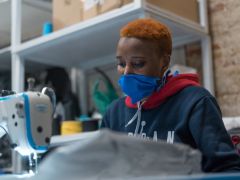 D-2388 What’s the Best Material for a Mask?
D-2388 What’s the Best Material for a Mask?Federal health officials have now recommended that we cover our faces with fabric during the coronavirus pandemic. But what material offers the most protection?
The Centers for Disease Control and Prevention has posted a no-sew mask pattern using a bandanna and a coffee filter as well as a video on making masks using rubber bands and folded fabrics found at home.
While a simple face covering can reduce the spread of coronavirus by blocking outgoing germs from coughs or sneezes of an infected person, experts say there is more variation in how much homemade masks might protect the wearer from incoming germs, depending on the fit and quality of the material used.
Scientists around the country have taken it upon themselves to identify everyday materials that do a better job of filtering microscopic particles. In recent tests, HEPA furnace filters scored well, as did vacuum cleaner bags, layers of 600-count pillowcases and fabric similar to flannel pajamas. Stacked coffee filters had medium scores. Scarves and bandanna material had the lowest scores, but still captured a small percentage of particles.
If you don’t have any of the materials that were tested, a simple light test can help you decide whether a fabric is a good candidate for a mask.
“Hold it up to a bright light,” said Dr. Scott Segal, chairman of anesthesiology at Wake Forest Baptist Health who recently studied homemade masks. “If light passes really easily through the fibers and you can almost see the fibers, it’s not a good fabric. If it’s a denser weave of thicker material and light doesn’t pass through it as much, that’s the material you want to use.”
Researchers say it’s important to remember that lab studies are conducted under perfect conditions with no leaks or gaps in the mask, but the test methods give us a way to compare materials. And while the degree of filtration for some homemade masks seems low, most of us — who are staying home and practicing social distancing in public — don’t need the high level of protection required for medical workers. More important, any face covering is better than none, especially if worn by a person who has the virus but doesn’t know it.
The biggest challenge of choosing a homemade mask material is to find a fabric that is dense enough to capture viral particles, but breathable enough that we can actually wear it. Some items being touted online promise high filtration scores, but the material would be unwearable.
Dressing Up for Work … at Home
Yang Wang, an assistant professor of environmental engineering at Missouri University of Science and Technology, worked with his graduate students to study various combinations of layered materials — including both air filters and fabric. “You need something that is efficient for removing particles, but you also need to breathe,” said Dr. Wang, who last fall won an international award for aerosol research.To test everyday materials, scientists are using methods similar to those used to test medical masks, which everybody agrees should be saved for medical workers who are exposed to high doses of virus from seeing infected patients. The best medical mask — called the N95 respirator — filters out at least 95 percent of particles as small as 0.3 microns. By comparison, a typical surgical mask — made using a rectangular piece of pleated fabric with elastic ear loops — has a filtration efficiency ranging from 60 to 80 percent.
Dr. Wang’s group tested two types of air filters. An allergy-reduction HVAC filter worked the best, capturing 89 percent of particles with one layer and 94 percent with two layers. A furnace filter captured 75 percent with two layers, but required six layers to achieve 95 percent. To find a filter similar to those tested, look for a minimum efficiency reporting value (MERV) rating of 12 or higher or a microparticle performance rating of 1900 or higher.
The problem with air filters is that they potentially could shed small fibers that would be risky to inhale. So if you want to use a filter, you need to sandwich the filter between two layers of cotton fabric. Dr. Wang said one of his grad students made his own mask by following the instructions in the C.D.C. video, but adding several layers of filter material inside a bandanna.
Dr. Wang’s group also found that when certain common fabrics were used, two layers offered far less protection than four layers. A 600 thread count pillow case captured just 22 percent of particles when doubled, but four layers captured nearly 60 percent. A thick woolen yarn scarf filtered 21 percent of particles in two layers, and 48.8 percent in four layers. A 100 percent cotton bandanna did the worst, capturing only 18.2 percent when doubled, and just 19.5 percent in four layers.
The group also tested Brew Rite and Natural Brew basket-style coffee filters, which, when stacked in three layers, showed 40 to 50 percent filtration efficiency — but they were less breathable than other options.
If you are lucky enough to know a quilter, ask them to make you a mask. Tests performed at the Wake Forest Institute for Regenerative Medicine in Winston-Salem, N.C., showed good results for homemade masks using quilting fabric. Dr. Segal, of Wake Forest Baptist Health, who led the study, noted that quilters tend to use high-quality, high-thread count cotton. The best homemade masks in his study were as good as surgical masks or slightly better, testing in the range of 70 to 79 percent filtration. Homemade masks that used flimsier fabric tested as low as 1 percent filtration, Dr. Segal said.
The best-performing designs were a mask constructed of two layers of high-quality, heavyweight “quilter’s cotton,” a two-layer mask made with thick batik fabric, and a double-layer mask with an inner layer of flannel and outer layer of cotton.
Bonnie Browning, executive show director for the American Quilter’s Society, said that quilters prefer tightly woven cottons and batik fabrics that stand up over time. Ms. Browning said most sewing machines can handle only two layers of fabric when making a pleated mask, but someone who wanted four layers of protection could wear two masks at a time.
Ms. Browning said she recently reached out to quilters on Facebook and heard from 71 people who have made a combined total of nearly 15,000 masks. “We quilters are very much in the thick of what’s going on with this,” said Ms. Browning, who lives in Paducah, Ky. “One thing most of us have is a stash of fabric.”
People who don’t sew could try a folded origami mask, created by Jiangmei Wu, assistant professor of interior design at Indiana University. Ms. Wu, who is known for her breathtaking folded artwork, said she began designing a folded mask out of a medical and building material called Tyvek, as well as vacuum bags, after her brother in Hong Kong, where mask wearing is common, suggested it. (DuPont, the maker of Tyvek, said in a statement that Tyvek is intended for medical apparel, not masks.) The folded mask pattern is free online, as is a video demonstrating the folding process. In tests at Missouri University and University of Virginia, scientists found that vacuum bags removed between 60 percent and 87 percent of particles. But some brands of vacuum bags may contain fiberglass or are harder to breathe through than other materials, and shouldn’t be used. Ms. Wu used a bag by EnviroCare Technologies, which has said it does not use fiberglass in its paper and synthetic cloth bags.
“I wanted to create an alternative for people who don’t sew,” said Ms. Wu, who said she is talking to various groups to find other materials that will be effective in a folded mask. “Given the shortage of all kinds of materials, even vacuum bags might run out.”
The scientists who conducted the tests used a standard of 0.3 microns because that is the measure used by the National Institute for Occupational Safety and Health for medical masks.
Linsey Marr, a Virginia Tech aerosol scientist and an expert in the transmission of viruses, said the certification method for respirators and HEPA filters focuses on 0.3 microns because particles around that size are the hardest to catch. While it seems counterintuitive, particles smaller than 0.1 microns are actually easier to catch because they have a lot of random motion that makes them bump into the filter fibers, she said.
“Even though coronavirus is around 0.1 microns, it floats around in a wide range of sizes, from around 0.2 to several hundred microns, because people shed the virus in respiratory fluid droplets that also contain lots of salts and proteins and other things,” said Dr. Marr. “Even if the water in the droplets fully evaporates, there’s still a lot of salt and proteins and other gunk that stays behind as solid or gel-like material. I think 0.3 microns is still useful for guidance because the minimum filtration efficiency will be somewhere around this size, and it’s what NIOSH uses.”
Learn More -
 K-1782 AUTOMATIC BAGGING LINE MOD. EASY BAG - WITHOUT LEAFLET INSERTIONREFERENCE NUMBER: K-1782 AUTOMATIC BAGGING LINE MOD. EASY BAG - WITHOUT LEAFLET INSERTION DESCRIPTION: THIS IS AN AUTOMATIC LINE COMPLETE WITH ROBOTIC MACHINES SPECIFICALLY FOR FILLING PILLOWS AND CUSHIONS INTO PLASTIC BAGS WITH PRESS AND WELDING SYSTEM WITH BAGGED CUSHIONS AUTOMATIC OUTPUT. QUANTITY AVAILABLE: 1 Learn More
K-1782 AUTOMATIC BAGGING LINE MOD. EASY BAG - WITHOUT LEAFLET INSERTIONREFERENCE NUMBER: K-1782 AUTOMATIC BAGGING LINE MOD. EASY BAG - WITHOUT LEAFLET INSERTION DESCRIPTION: THIS IS AN AUTOMATIC LINE COMPLETE WITH ROBOTIC MACHINES SPECIFICALLY FOR FILLING PILLOWS AND CUSHIONS INTO PLASTIC BAGS WITH PRESS AND WELDING SYSTEM WITH BAGGED CUSHIONS AUTOMATIC OUTPUT. QUANTITY AVAILABLE: 1 Learn More -
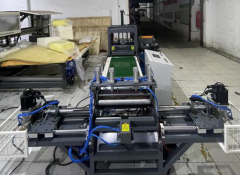 J-4026 FLAT PILLOW ROLLER, FLATTENING AND ROLLING MACHINE – 6 PIECES PER MINUTEJ-4026 FLAT PILLOW ROLLER, FLATTENING AND ROLLING MACHINE – 6 PIECES PER MINUTE POWER: 11.2 KW WEIGHT: 1000 KG AIR PRESSURE: 0.4 TO 0.8 Mpa FRONT BELT CONVEYOR: 750 x 1430 x 700mm PRESSING PLATE BELT: 650 x 1100mm PRESSING PLATE: 750 x 950mm STROKE HEIGHT: 300mm MIDDLE BELT CONVEYOR: 800 x 1800 x 750mm WRAPPING MACHINE: 620 x 2800 x 1200mm ELECTRIC CABINET: 450 x 800 x 1000mm OVERALL DIMENSIONS: 2800 x 5100 x 2050mm OVERALL VOLUME: 13 CUBIC METERS QUANTITY: 1 Learn More
J-4026 FLAT PILLOW ROLLER, FLATTENING AND ROLLING MACHINE – 6 PIECES PER MINUTEJ-4026 FLAT PILLOW ROLLER, FLATTENING AND ROLLING MACHINE – 6 PIECES PER MINUTE POWER: 11.2 KW WEIGHT: 1000 KG AIR PRESSURE: 0.4 TO 0.8 Mpa FRONT BELT CONVEYOR: 750 x 1430 x 700mm PRESSING PLATE BELT: 650 x 1100mm PRESSING PLATE: 750 x 950mm STROKE HEIGHT: 300mm MIDDLE BELT CONVEYOR: 800 x 1800 x 750mm WRAPPING MACHINE: 620 x 2800 x 1200mm ELECTRIC CABINET: 450 x 800 x 1000mm OVERALL DIMENSIONS: 2800 x 5100 x 2050mm OVERALL VOLUME: 13 CUBIC METERS QUANTITY: 1 Learn More -
 TT-8350 EUROSICMA EURO 77/TIV PILLOW-PACK, 500 TO 800 PACKS PER MINTT-8350 EUROSICMA EURO 77/TIV PILLOW-PACK, 500 TO 800 PACKS PER MIN 1. BRAND: EUROSICMA 2. MODEL: EURO 77/TIV 3. CONDITION: REFURBISHED QUANTITY: 1 Learn More
TT-8350 EUROSICMA EURO 77/TIV PILLOW-PACK, 500 TO 800 PACKS PER MINTT-8350 EUROSICMA EURO 77/TIV PILLOW-PACK, 500 TO 800 PACKS PER MIN 1. BRAND: EUROSICMA 2. MODEL: EURO 77/TIV 3. CONDITION: REFURBISHED QUANTITY: 1 Learn More -
 TT-6463 WISE FIBER PILLOW BLOWING SYSTEMTT-6463 WISE FIBER PILLOW BLOWING SYSTEM EXCELLENT CONDITION QUANTITY: 1 Learn More
TT-6463 WISE FIBER PILLOW BLOWING SYSTEMTT-6463 WISE FIBER PILLOW BLOWING SYSTEM EXCELLENT CONDITION QUANTITY: 1 Learn More
